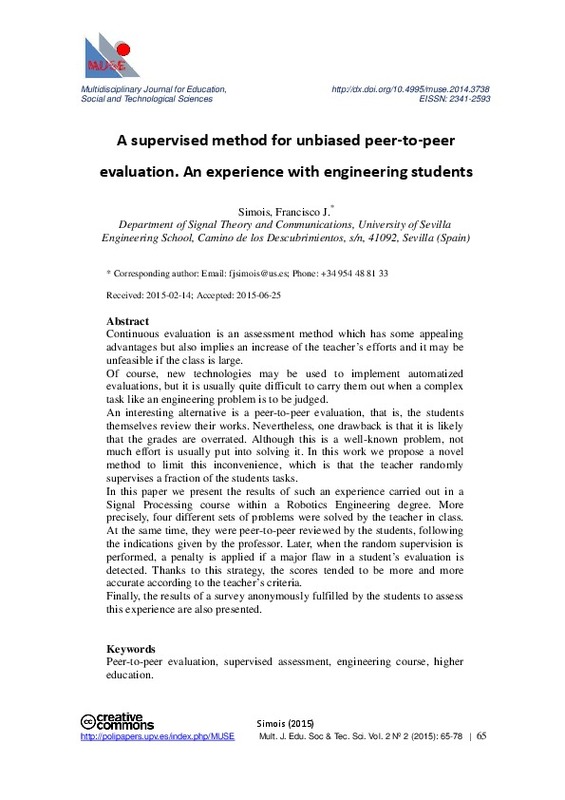JavaScript is disabled for your browser. Some features of this site may not work without it.
Buscar en RiuNet
Listar
Mi cuenta
Estadísticas
Ayuda RiuNet
Admin. UPV
A supervised method for unbiased peer-to-peer evaluation. An experience with engineering students
Mostrar el registro sencillo del ítem
Ficheros en el ítem
| dc.contributor.author | Simois, Francisco J.
|
es_ES |
| dc.date.accessioned | 2017-01-16T12:42:08Z | |
| dc.date.available | 2017-01-16T12:42:08Z | |
| dc.date.issued | 2015-09-23 | |
| dc.identifier.uri | http://hdl.handle.net/10251/76872 | |
| dc.description.abstract | [EN] Continuous evaluation is an assessment method which has some appealing advantages but also implies an increase of the teacher’s efforts and it may be unfeasible if the class is large.Of course, new technologies may be used to implement automatized evaluations, but it is usually quite difficult to carry them out when a complex task like an engineering problem is to be judged.An interesting alternative is a peer-to-peer evaluation, that is, the students themselves review their works. Nevertheless, one drawback is that it is likely that the grades are overrated. Although this is a well-known problem, not much effort is usually put into solving it. In this work we propose a novel method to limit this inconvenience, which is that the teacher randomly supervises a fraction of the students tasks.In this paper we present the results of such an experience carried out in a Signal Processing course within a Robotics Engineering degree. More precisely, four different sets of problems were solved by the teacher in class. At the same time, they were peer-to-peer reviewed by the students, following the indications given by the professor. Later, when the random supervision is performed, a penalty is applied if a major flaw in a student’s evaluation is detected. Thanks to this strategy, the scores tended to be more and more accurate according to the teacher’s criteria.Finally, the results of a survey anonymously fulfilled by the students to assess this experience are also presented. | es_ES |
| dc.language | Inglés | es_ES |
| dc.publisher | Universitat Politècnica de València | |
| dc.relation.ispartof | Multidisciplinary Journal for Education, Social and Technological Sciences | |
| dc.rights | Reconocimiento - No comercial - Sin obra derivada (by-nc-nd) | es_ES |
| dc.subject | Peer-to-peer evaluation | es_ES |
| dc.subject | Supervised assessment | es_ES |
| dc.subject | Engineering course | es_ES |
| dc.subject | Higher education | es_ES |
| dc.subject | Continuous evaluation | es_ES |
| dc.title | A supervised method for unbiased peer-to-peer evaluation. An experience with engineering students | es_ES |
| dc.type | Artículo | es_ES |
| dc.date.updated | 2017-01-16T12:21:50Z | |
| dc.identifier.doi | 10.4995/muse.2015.3738 | |
| dc.rights.accessRights | Abierto | es_ES |
| dc.description.bibliographicCitation | Simois, FJ. (2015). A supervised method for unbiased peer-to-peer evaluation. An experience with engineering students. Multidisciplinary Journal for Education, Social and Technological Sciences. 2(2):65-78. https://doi.org/10.4995/muse.2015.3738 | es_ES |
| dc.description.accrualMethod | SWORD | es_ES |
| dc.relation.publisherversion | https://doi.org/10.4995/muse.2015.3738 | es_ES |
| dc.description.upvformatpinicio | 65 | es_ES |
| dc.description.upvformatpfin | 78 | es_ES |
| dc.type.version | info:eu-repo/semantics/publishedVersion | es_ES |
| dc.description.volume | 2 | |
| dc.description.issue | 2 | |
| dc.identifier.eissn | 2341-2593 |








